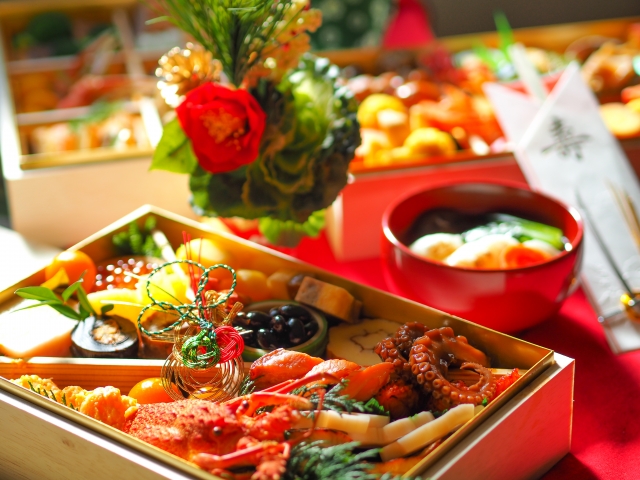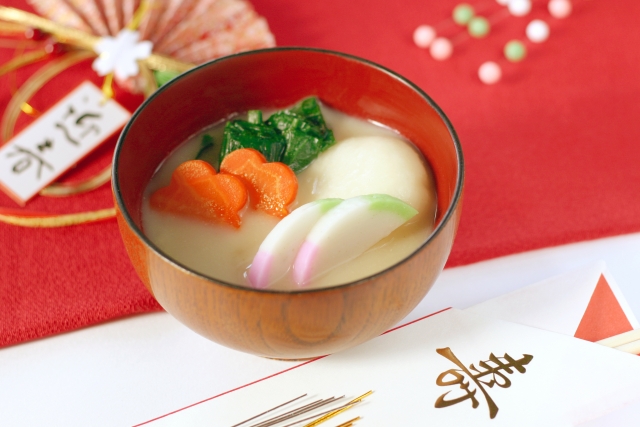Happy New Year! We hope that you will enjoy travelling this year too with Omega Communications on our culinary trip around the world.
Our first stop on this year’s trip will be right here in Japan. This time we will be giving you a bite sized introduction to that familiar but also unfamiliar world of Japanese New Year’s cuisine.
The History of Osechi-ryori
Osechi-ryori dates back to the Yayoi period (approximately 400 BC to 300 AD)*1. The event of preparing food as an offering to deities at seasonal festivals was introduced from China and, during the latter part of the Edo period (1790–1850), the custom of New Year’s cuisine was established.
Much of the osechi-ryori sold in department stores are nests of boxes containing multiple stacked layers, a design that was established between the end of the Edo period (1853–1868) and the beginning of the Meiji era (1868–). The reasons for stacking the layers this way include, many different dishes can be compactly stored in one nest of boxes and, when served at home, it’s easy to serve to guests. However, it also carries the meaning of stacking layers, stacking blessings.

The name osechi actually first came into use after the Second World War. Until then it was called by other names such as kuizumi and horai.
A Classic of New Year’s—Ozoni
Another staple of New Year’s that goes hand-in-hand with osechi-ryori is ozoni (mochi soup). This dish, which has been eaten since the Heian period (794–1185), is also steeped in history. The ozoni would be made with the first water drawn from the river or well, cooked on the first fire lit that year and then eaten on New Year’s Day.

There are many variations of ozoni, with each region and household using its own different shape of mochi, ingredients, soup, etc. In the Kansai district many use a round mochi and eat it with white miso whereas in the Kanto district, using a square shaped mochi and eating with sumashi jiru (clear soup) is more common.
Here at Omega Communications, we asked the staff about what kind of ozoni they eat each year and the results stirred up quite a lively discussion. Several members of staff from the office put produce exclusive to their home prefectures in their ozoni; a member of staff from the Chiba Prefecture tops theirs with habanori seaweed, whereas a member of staff from the Ibaraki Prefecture puts lotus root in theirs. One member of staff, who was raised in a temple in the Shonai region, Yamagata Prefecture, enjoys their ozoni using a round mochi, which is unusual for the Kanto district, taro, daikon, carrot, burdock and deep-fried tofu and red taro stems.
It may be difficult to take a trip home at the moment, but perhaps by talking with those close to you about the differences between your osechi-ryori and ozoni and theirs, you may be able to stir up some memories of your hometown.
Our next destination is Japan’s neighbor, Korea. We will introduce the cuisine of this country which is gaining attention for its television dramas and music scene. We hope you are looking forward to it.
[Footnotes]
*1 According to the Kita City Asukayama Museum official website
<https://www.city.kita.tokyo.jp/hakubutsukan/rekishi/ayumi/ayumi/nenpyo.html>
[References]
“What is ozoni? An introduction to its origins!” Taiwa Gakuen Education Inc. Kyoto, Japan (website), accessed January 7, 2021.
<https://www.kyoto-chorishi.ac.jp/knowledge/c0014/>
“Let’s get to know the history and origins of osechi-ryori,” Gurusuguri (website), accessed January 7, 2021.
<https://gurusuguri.com/special/season/osechi/spcu-osechi_yurai/?__ngt__=TT0ee09b998003ac1e4ae205U2WjA2WBpcOBPsba8ESx2U>
We are accepting applications for writing tourism and cultural articles in Japanese and/or English, multilingual translations and other services. For inquiries, please contact us:
Tel: (+81) 3-6902-9030
Email: info@omega-com.co.jp
Note: Unauthorized copying and replication of the contents of this site, text and images are strictly prohibited. All Rights Reserved.
